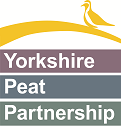Why restore peatlands?
Coir reservoir on Stake Moss © Chris Osborne
Peatlands are the underdog habitat. Few people understand the full suite of benefits healthy peatlands provide and, for this reason, they have been overused, damaged and degraded almost to the point of no return. But there is still time to save our Cinderella habitat and Yorkshire Peat Partnership is ready with a pumpkin coach and a glass slipper. Here’s why we do it:
- peatlands store carbon. Healthy peatlands are waterlogged, which means that when the plants decompose, they don’t release their carbon dioxide back to the atmosphere; instead, it is locked up and stored as peat. When vegetation is removed or the water table drops and bare peat is exposed, the peat oxidises and releases CO2 back into the atmosphere. Globally, peatlands store twice as much carbon as all the world’s forests so they are vital in our fight against climate change.
- peatlands help reduce the risk of flooding. Everybody remembers the devastation caused by the 2015/16 Boxing Day floods. As climate change ramps up, the frequency of these events is likely to increase. We must therefore put our natural environment in the best condition to protect us and to mitigate the effects. Healthy peatlands slow the flow of rainfall off the hills, leading to less dramatic peak flows lower down the valleys. When grips and gullies are filled in, more water remains at the top of the catchment and flows down more slowly, reducing the flood peak in towns and cities. Healthy peatlands also naturally filter drinking water, which reduces the cost of cleaning water.
- peatlands are home to rare and iconic wildlife. Birds like curlew and golden plover, plants like cotton grass and the carnivorous sundew, and animals like lizards and voles call peatlands home. The blanket bog we have in this country is an internationally important habitat for these species and when it’s gone, it’s gone; so it is vital for Yorkshire’s wildlife that we repair and conserve these habitats to safeguard these species’ future.
- peatlands are an archaeological record. Intact peat holds millennia of historic data on human history, climate and land use; they provide a ‘slice of history’ preserving records of past environmental changes. Due to the acidic, anaerobic, waterlogged conditions, material is much better preserved than in dry habitats. Because of this, peatlands have given us spectacular finds like the Iron Age bog body, Lindow Man.
- peatlands also provide a place for peace and quiet, a space to breathe, away from the hustle and bustle. Walkers, cyclists, climbers, horse riders, runners, birders, field sports enthusiasts, all use and enjoy the wildness of these stunning landscapes.
The cost of restoring peatlands pales into insignificance when you look at the ongoing cost to society year on year of degraded peatland. What other habitat stores carbon and mitigates against climate change, reduces the risk of flooding and filters water, is home to wildlife found nowhere else, and, provides a record of our own existence? Peatlands are our rainforests.








